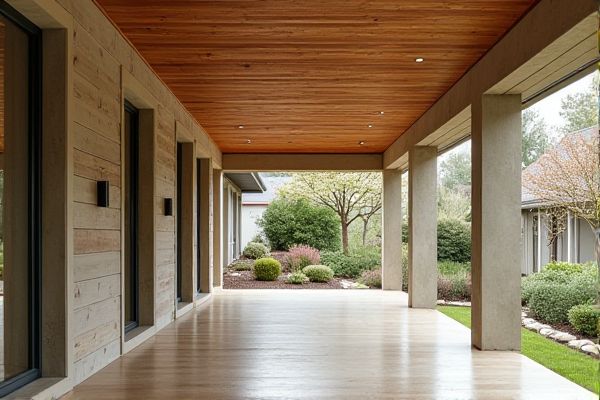
Wood ceilings offer a natural, warm aesthetic and excellent durability, perfect for adding character to your porch, while PVC ceilings provide a low-maintenance, water-resistant alternative ideal for areas prone to moisture. Discover which ceiling option best suits your porch's style and functionality by exploring the key benefits and drawbacks in the rest of this article.
Table of Comparison
| Feature | Wood Ceiling | PVC Ceiling |
|---|---|---|
| Material | Natural hardwood or softwood | Polyvinyl chloride (PVC) plastic |
| Durability | Moderate; prone to moisture damage and termites | High; waterproof, termite-proof, and weather-resistant |
| Maintenance | Requires regular sealing and polishing | Low maintenance; easy to clean with water |
| Installation | Labor-intensive; requires skilled carpentry | Quick and simple installation with interlocking panels |
| Cost | Higher initial cost due to material and labor | Generally affordable with lower labor costs |
| Appearance | Natural, warm, and elegant look | Variety of colors and designs, mimics wood grain |
| Environmental Impact | Renewable if sourced sustainably | Non-biodegradable; plastic-based |
| Suitability for Porch | Good for covered porches with protection from rain | Ideal for exposed porches due to waterproof properties |
Introduction: Choosing the Right Ceiling for Your Porch
Wood ceilings provide natural insulation, durability, and an elegant appearance that enhances porch aesthetics with warm tones and unique grain patterns. PVC ceilings offer moisture resistance, low maintenance, and cost-effectiveness, making them ideal for humid or exposed porch areas. Selecting between wood and PVC ceilings depends on factors such as climate, budget, and desired aesthetic appeal for your outdoor space.
Overview: Wood Ceilings vs PVC Ceilings
Wood ceilings offer natural warmth, durability, and a classic aesthetic ideal for porches, enhancing outdoor ambiance with their rich textures and grains. PVC ceilings provide a lightweight, moisture-resistant, and low-maintenance alternative that resists warping and insect damage, making them highly suitable for humid or rainy environments. Choosing between wood and PVC for your porch ceiling depends on your preference for natural beauty versus ease of upkeep and environmental resilience.
Aesthetic Appeal and Design Flexibility
Wood ceilings offer a natural, warm aesthetic that enhances porch spaces with rich textures and timeless appeal, making them ideal for rustic or traditional designs. PVC ceilings provide exceptional design flexibility, available in various colors, patterns, and finishes that mimic wood and other materials while offering moisture resistance and low maintenance. Choosing between wood and PVC depends on the desired balance of authentic beauty versus versatile customization and durability for outdoor porch environments.
Durability and Weather Resistance
Wood ceilings offer natural durability and can withstand moderate weather conditions when properly treated with sealants and finishes, but are prone to moisture damage, warping, and insect infestations over time. PVC ceilings provide superior weather resistance due to their waterproof, rot-proof, and insect-resistant properties, making them ideal for porch areas exposed to rain and humidity. The low maintenance and long-lasting durability of PVC make it a practical choice for exterior ceilings requiring resilience against varying weather elements.
Maintenance Requirements and Longevity
Wood ceilings require regular maintenance including sealing, staining, or painting to protect against moisture, insects, and UV damage, ensuring durability over time. PVC ceilings offer low maintenance, being resistant to water, mold, and pests, making them ideal for outdoor porch applications with minimal upkeep. While wood can last several decades with proper care, PVC typically provides a lifespan of 20-30 years with minimal maintenance investment.
Installation Process and Complexity
Wood ceiling installation for porches involves precise measuring, cutting, and securing wooden planks or panels to a framework, often requiring specialized tools and skilled labor to ensure proper alignment and fastening. PVC ceiling panels, made from lightweight plastic, offer a simpler installation process with interlocking or snap-together systems that require minimal tools and reduce installation time significantly. Wood ceilings may demand moisture treatment and sealing to prevent warping, while PVC ceilings provide inherent water resistance, making the installation less complex in humid or wet porch environments.
Cost Comparison: Wood vs PVC Ceilings
Wood ceilings generally cost between $8 to $15 per square foot, factoring in material and installation expenses, making them pricier than PVC ceilings, which range from $3 to $7 per square foot. Wood ceilings offer natural aesthetics and durability but require regular maintenance and are susceptible to moisture damage, increasing long-term costs. PVC ceilings provide a cost-effective, low-maintenance alternative resistant to water and insects, ideal for porch areas with high exposure to weather elements.
Environmental Impact and Sustainability
Wood ceilings offer a renewable and biodegradable option, especially when sourced from sustainably managed forests, reducing your environmental footprint. PVC ceilings, derived from non-renewable fossil fuels, pose challenges due to their production emissions and long decomposition time in landfills. Choosing wood for your porch ceiling supports sustainability goals through carbon sequestration and lower overall environmental impact.
Insulation and Acoustic Properties
Wood ceilings provide superior natural insulation and excellent acoustic properties, reducing noise transmission and enhancing sound absorption in porch areas. PVC ceilings offer moderate insulation but lack the sound-dampening qualities of wood, often resulting in higher noise reflection. Choosing wood ceilings improves thermal comfort and noise control, making them ideal for porches requiring enhanced energy efficiency and quieter environments.
Final Verdict: Which Ceiling is Best for Your Porch?
Wood ceilings offer a natural, warm aesthetic and superior insulation, making them ideal for porches in cooler climates, while PVC ceilings provide excellent moisture resistance, low maintenance, and durability perfect for humid or rainy areas. Your choice depends on whether you prioritize traditional beauty and insulation or long-lasting, weather-resistant functionality. For porches exposed to harsh weather, PVC ceilings typically offer the best value and longevity, whereas wood is preferable for creating a cozy, classic atmosphere.
 homyna.com
homyna.com